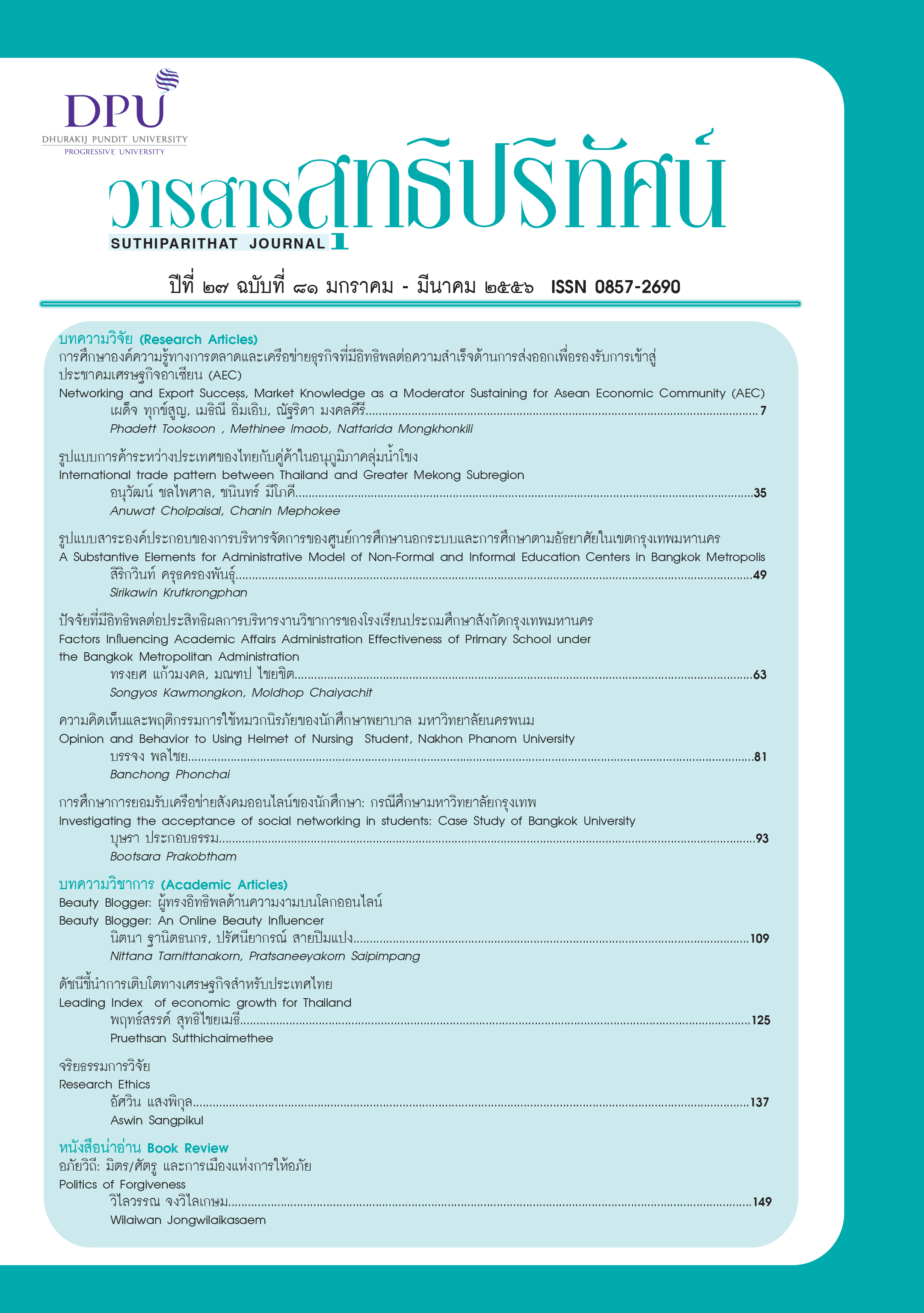การศึกษาการยอมรับเครือข่ายสังคมออนไลน์ของนักศึกษา: กรณีศึกษามหาวิทยาลัยกรุงเทพ
คำสำคัญ:
เครือข่ายสังคมออนไลน์, แบบจำลองการยอมรับเทคโนโลยี, มหาวิทยาลัยกรุงเทพบทคัดย่อ
การวิจัยครั้งนี้มีวัตถุประสงค์เพื่อศึกษาปัจจัยที่ส่งผลต่อการยอมรับเครือข่ายสังคมออนไลน์ของนักศึกษา และความสัมพันธ์ของตัวแปรต่างๆ ที่มีอิทธิพลต่อการยอมรับเครือข่ายสังคมออนไลน์ของนักศึกษา โดยใช้แบบจำลองการยอมรับเทคโนโลยี (TAM) การวิจัยนี้เป็นการวิจัยเชิงสำรวจ โดยใช้แบบสอบถามเป็นเครื่องมือในการเก็บรวบรวมข้อมูลจากนักศึกษามหาวิทยาลัยกรุงเทพจำนวน 400 คน ใช้วิธีการสุ่มตัวอย่างแบบแบ่งชั้นตามคณะ ผลการวิจัยพบว่า การรับรู้ความง่ายในการใช้งาน การรับรู้ประโยชน์และอิทธิพลของสังคม มีอิทธิพลต่อทัศนคติที่มีต่อการใช้เครือข่ายสังคมออนไลน์และทัศนคติที่มีต่อการใช้เครือข่ายสังคมออนไลน์มีอิทธิพลต่อความตั้งใจใช้เครือข่ายสังคมออนไลน์ ที่ระดับนัยสำคัญ 0.01 จากผลการวิจัยสถาบันการศึกษาสามารถนำเครือข่ายสังคมออนไลน์ไปใช้ประโยชน์ในการเผยแพร่ข้อมูลข่าวสารต่างๆ ได้สะดวกรวดเร็ว นอกจากนี้อาจารย์ผู้สอนจะสามารถใช้เป็นช่องทางในการติดต่อสื่อสารกับนักศึกษาได้ง่ายขึ้น
เอกสารอ้างอิง
Agarwal, P., & Prasad, J. (1997). The Role of innovation characteristic and perceived voluntariness in the acceptance of information technologies. Decision Sciences, 28, 557-582.
Ajjan, H., & Fishbein, M. (1980). Understanding attitudes and predicting behavior. Englewood Cliffs, NJ: Prentice Hall.
Ajjan, H., & Hartshorne, R. (2008). Investigating faculty decisions to adopt Web 2.0 technologies: Theory and empirical tests. The Internet and Higher Education, 11(2), 179-211.
Davis, F. D. (1989). Perceived usefulness, perceived ease of use, and user acceptance of information technology. MIS Quarterly, 13(3), 319-339.
Davis, F. D., Bagozzi, R., & Warshaw, P. (1989). User acceptance of computer technology: A Comparision of two theoretical models. Management Science, 35, 982-1003.
Erickson, T. (2002). Some problems with the notion of context-aware computing. Communications of the ACM, 45, 102–104.
Fishbein, M., & Ajzen, I. (1975). Belief, attitude, intention, and behavior: An Introduction to theory and research. MA: Addison-Wesley, Reading.
Internet Usage Statistics. (2011). Retrieved June 25, 2012, from http://www.internetworldstats.com/stats.htm
Jackson, C., Chow, S., & Leitch, R. (1997). Toward an understanding of the behavioral intention to use an information system. Decision Sciences, 28, 357-389.
Kwon, O. (2004). Modeling and generating context-aware agent-based applications with amended colored petri nets. Expert Systems with Applications, 27, 609–621.
Mason, R. (2006). Learning technologies for adult continuing education. Studies in Continuing Education, 28(2), 121-133.
Venkatesh, V. (1999). Creation of favorable uses perceptions: Exploring the role of intrinsic motivation. MIS Quarterly, 23, 239-260.
Venkatesh, V., Morris, M., Davis, G., & Davis, F. (2003). User acceptance of information technology: Toward a unified view. MIS Quarterly, 27, 425–478.
Yamane, Taro. (1973). Statistics: An Introductory Analysis (3rd ed.). New York: Harper and Row Publication.
ดาวน์โหลด
เผยแพร่แล้ว
รูปแบบการอ้างอิง
ฉบับ
ประเภทบทความ
สัญญาอนุญาต
เนื้อหาและข้อมูลในบทความที่ลงตีพิมพ์ในวารสารสุทธิปริทัศน์ ถือเป็นข้อคิดเห็นและความรับผิดชอบของผู้เขียนบทความโดยตรงซึ่งกองบรรณาธิการวารสาร ไม่จำเป็นต้องเห็นด้วย หรือร่วมรับผิดชอบใด ๆ
บทความ ข้อมูล เนื้อหา รูปภาพ ฯลฯ ที่ได้รับการตีพิมพ์ในวารสารสุทธิปริทัศน์ ถือเป็นลิขสิทธิ์ของวารสารสุทธิปริทัศน์หากบุคคลหรือหน่วยงานใดต้องการนำทั้งหมดหรือส่วนหนึ่งส่วนใดไปเผยแพร่ต่อหรือเพื่อกระทำการใด ๆ จะต้องได้รับอนุญาตเป็นลายลักษณ์อักษรจากวารสารสุทธิปริทัศน์ก่อนเท่านั้น







